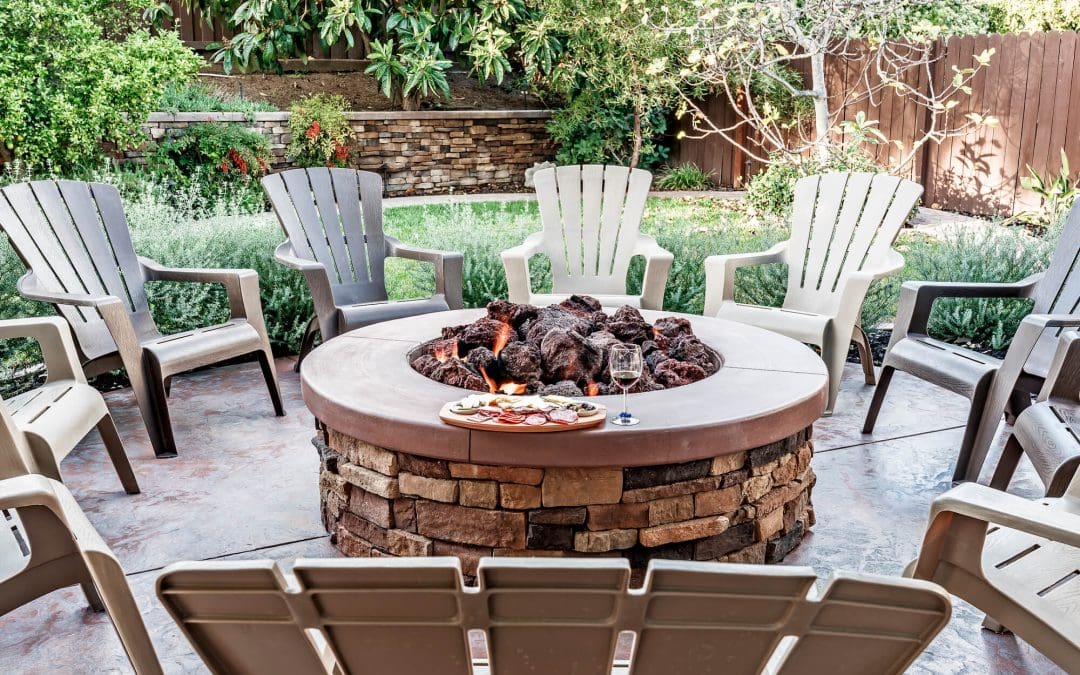A fire pit can turn an ordinary evening into something special—quiet conversation, a few toasted marshmallows, and a little warmth under the stars. But that relaxing night can go sideways fast if you’re not careful. Fire pits are open flames, and like any fire, they need to be handled with respect. Before you strike a match, make sure your setup and habits are safe. Here are a few fire pit safety tips every homeowner should know to enjoy their fire pit without risking property damage or injury.
Choose the Right Spot for Fire Pit Safety
Location matters more than most people realize. Your fire pit should be at least 10 to 20 feet away from your home, trees, fences, sheds, or anything else that can catch fire. That includes overhead branches. Even if the flames stay low, flying embers can drift and spark a fire where you’re not looking.
A fire pit should always be placed on a non-flammable surface. Stone, gravel, concrete, or a fire-resistant pad are all good options. Never place a fire pit directly on a wooden deck or in the grass unless it’s specifically designed for that kind of use.
Watch the Wind
A calm night is the best time for a backyard fire. Wind can blow flames, embers, or smoke in unexpected directions. If it’s breezy, wait it out. If the wind suddenly picks up while the fire is burning, it’s best to extinguish it and play it safe.
Even on calm nights, be mindful of where the smoke is drifting. You don’t want it blowing toward your house, into open windows, or over the neighbor’s fence.
Using the Right Fuel is Crucial for Fire Pit Safety
Only burn dry, seasoned wood. It burns cleaner, hotter, and with less smoke. Avoid softwoods like pine, which crackle and pop more because of the resin. Never burn trash, treated lumber, cardboard, or anything with paint or chemicals. These release toxic fumes and can cause unpredictable flare-ups.
Fire starters like fatwood or commercial fire logs are fine as long as they’re used correctly. Never use gasoline or lighter fluid to get things going. If you need help lighting the fire, there are safer alternatives like natural fire starters or chimney starters.
Keep a Close Eye on the Flame
Once the fire’s lit, don’t leave it unattended, not even for a minute. Things can go wrong quickly, especially if kids or pets are nearby.
Keep your fire small and manageable. A towering flame isn’t necessary, and it increases the chances of sparks flying out of the pit. Most backyard fires don’t need to be more than a couple of feet high.
Have a hose, a bucket of water, or a fire extinguisher nearby. You probably won’t need it, but if you do, you’ll need it fast.
Stay Clear of Combustibles
Furniture, umbrellas, dry leaves, and even some outdoor cushions can catch fire if they’re too close. Keep a safe perimeter around the pit, and be cautious with anything that isn’t flame-resistant. Also, skip the tiki torches and citronella candles nearby when you’ve got a fire burning.
Be careful with loose clothing. Scarves, wide sleeves, or anything flowing can easily catch the flame if someone leans in too close. Keep chairs at a safe distance, and don’t let anyone crowd the pit.
Extinguish the Fire Completely
When it’s time to shut it down, do it the right way. Spread the embers out, then slowly pour water over them. You’ll hear hissing and see steam—that’s normal. Stir the ashes with a shovel or stick, and pour more water if needed. Don’t leave until everything is cold to the touch.
If you use a metal fire pit with a lid, covering it can help reduce leftover heat and contain embers. But don’t rely on the lid alone—make sure the fire is out completely before you call it a night.
Know Your Local Rules
Some cities and counties have fire regulations, especially during dry seasons. Check with your local fire department or municipality to make sure you’re not breaking any rules by lighting a backyard fire. Some areas require permits, and others might ban open flames altogether when conditions are risky.
A fire pit should bring people together, not cause damage and regret. A few simple habits and a little caution go a long way.
Fire Pit Safety FAQs
Can I use a fire pit on a wooden deck?
Only if the fire pit is designed for that kind of use and you have a fire-resistant barrier underneath it. Most experts recommend using fire pits on non-flammable surfaces instead.
Is it safe to leave a fire pit burning overnight?
No. Fires should always be extinguished completely before you leave them unattended or go to sleep. Even small embers can spark a fire hours later.
How do I keep kids safe around a fire pit?
Supervise them closely. Teach them to stay a safe distance away and explain why the fire is dangerous. Never assume they understand just by watching adults.
What should I do if the fire gets out of control?
Call 911 immediately, then use water, a hose, or a fire extinguisher to try to contain it. Don’t wait to see if it burns itself out.
Can I cook over my fire pit?
Yes, if it’s designed for it and you’re using clean, untreated wood. Avoid cooking over a fire with any chemicals or additives.
Home Inspection Protection provides home inspection services in Naples, Florida, and the surrounding area. Contact us to request an appointment.

